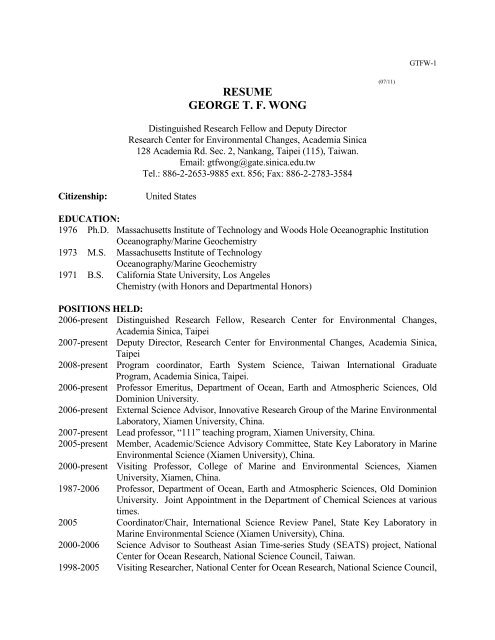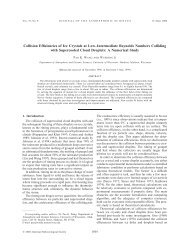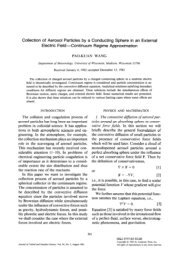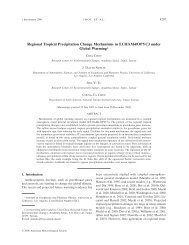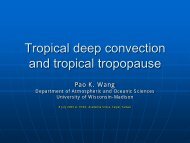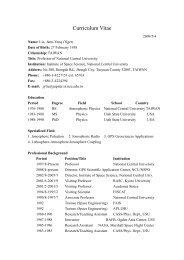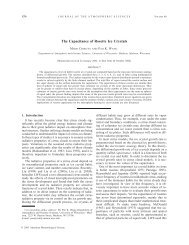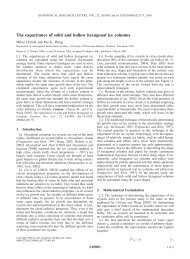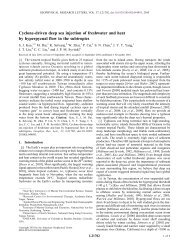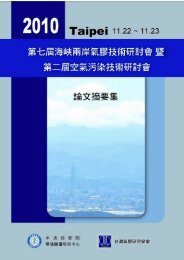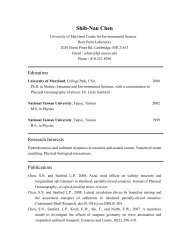RESUME GEORGE T. F. WONG - Academia Sinica
RESUME GEORGE T. F. WONG - Academia Sinica
RESUME GEORGE T. F. WONG - Academia Sinica
Create successful ePaper yourself
Turn your PDF publications into a flip-book with our unique Google optimized e-Paper software.
GTFW-1<br />
<strong>RESUME</strong><br />
<strong>GEORGE</strong> T. F. <strong>WONG</strong><br />
(07/11)<br />
Distinguished Research Fellow and Deputy Director<br />
Research Center for Environmental Changes, <strong>Academia</strong> <strong>Sinica</strong><br />
128 <strong>Academia</strong> Rd. Sec. 2, Nankang, Taipei (115), Taiwan.<br />
Email: gtfwong@gate.sinica.edu.tw<br />
Tel.: 886-2-2653-9885 ext. 856; Fax: 886-2-2783-3584<br />
Citizenship:<br />
United States<br />
EDUCATION:<br />
1976 Ph.D. Massachusetts Institute of Technology and Woods Hole Oceanographic Institution<br />
Oceanography/Marine Geochemistry<br />
1973 M.S. Massachusetts Institute of Technology<br />
Oceanography/Marine Geochemistry<br />
1971 B.S. California State University, Los Angeles<br />
Chemistry (with Honors and Departmental Honors)<br />
POSITIONS HELD:<br />
2006-present Distinguished Research Fellow, Research Center for Environmental Changes,<br />
<strong>Academia</strong> <strong>Sinica</strong>, Taipei<br />
2007-present Deputy Director, Research Center for Environmental Changes, <strong>Academia</strong> <strong>Sinica</strong>,<br />
Taipei<br />
2008-present Program coordinator, Earth System Science, Taiwan International Graduate<br />
Program, <strong>Academia</strong> <strong>Sinica</strong>, Taipei.<br />
2006-present Professor Emeritus, Department of Ocean, Earth and Atmospheric Sciences, Old<br />
Dominion University.<br />
2006-present External Science Advisor, Innovative Research Group of the Marine Environmental<br />
Laboratory, Xiamen University, China.<br />
2007-present Lead professor, “111” teaching program, Xiamen University, China.<br />
2005-present Member, Academic/Science Advisory Committee, State Key Laboratory in Marine<br />
Environmental Science (Xiamen University), China.<br />
2000-present Visiting Professor, College of Marine and Environmental Sciences, Xiamen<br />
University, Xiamen, China.<br />
1987-2006 Professor, Department of Ocean, Earth and Atmospheric Sciences, Old Dominion<br />
University. Joint Appointment in the Department of Chemical Sciences at various<br />
times.<br />
2005 Coordinator/Chair, International Science Review Panel, State Key Laboratory in<br />
Marine Environmental Science (Xiamen University), China.<br />
2000-2006 Science Advisor to Southeast Asian Time-series Study (SEATS) project, National<br />
Center for Ocean Research, National Science Council, Taiwan.<br />
1998-2005 Visiting Researcher, National Center for Ocean Research, National Science Council,
GTFW-2<br />
Taiwan.<br />
2000 Member, Program Review Team of the National Science Foundation of China to<br />
review the program in marine biogeochemistry at Xiamen University.<br />
1998 Member, Program Review Team of the National Taiwan University to review its<br />
Institute of Oceanography.<br />
1997-2000 Coordinator, Advisory Committee of the National Center for Ocean Research,<br />
National Science Council, Taiwan.<br />
1994 Visiting Professor, Institute of Oceanography, National Taiwan University.<br />
1981-1993 Chairman, Radiation Safety Committee, Old Dominion University.<br />
1991-1993 Consultant to Sidley & Austin Law Office.<br />
1991-1992 Consultant to Environmental Science & Engineering, Inc.<br />
1985-1990 Ph.D. Graduate Program Director, Department of Oceanography, Old Dominion<br />
University.<br />
1988 Visiting Professor, Institute of Oceanography, National Taiwan University.<br />
1986-1988 Academic Deputy Chairman, Department of Oceanography, Old Dominion<br />
University.<br />
1987 Early promotion to Professor granted by Old Dominion University<br />
1982-1987 Associate Professor, Department of Oceanography with a Joint Appointment in the<br />
Department of Chemical Sciences at various times, Old Dominion University.<br />
1981 Tenure and promotion to Associate Professor granted by Old Dominion University.<br />
1981-1982 Acting Radiation Safety Officer, Old Dominion University.<br />
1980-1981 Interim Director, Applied Marine Research Laboratory - Water Quality Laboratory,<br />
Old Dominion University.<br />
1978-1979 Consultant to the Breeden, Howard and MacMillan Law Office.<br />
1976-1982 Assistant Professor, Department of Oceanography with a Joint Appointment in the<br />
Department of Chemical Sciences, Old Dominion University.<br />
1976 Consultant to the Public Service Company.<br />
1976 Consultant to Woods Hole Oceanographic Institution.<br />
HONORS AND AWARDS:<br />
Phi Kappa Phi.<br />
Sigma Xi.<br />
Outstanding Achievement Award, Organization of Chinese American, East Virginia Chapter.<br />
ACADEMIC EXPERIENCES:<br />
Courses taught:<br />
Undergraduate level -<br />
Oceanography.<br />
Internship in Oceanography.<br />
M.S. level -<br />
Chemical Oceanography.<br />
Chemical Oceanography Laboratory.<br />
Advanced Chemical Oceanography (with Lab).<br />
Marine Geochemistry.
GTFW-3<br />
The Marine Geochemical Cycle.<br />
Research Strategies in Chemical Oceanography.<br />
Equilibrium Concepts of the Oceans.<br />
Ph.D. Level -<br />
Radiogeochemistry of the Oceans.<br />
The Ocean as a Chemical System.<br />
Biological-chemical Interactions in the Oceans.<br />
Aquatic Chemistry.<br />
Uranium Series Disequilibrium in the Oceans.<br />
Marine Biogeochemistry.<br />
Marine Biogeochemical Cycle.<br />
Marine Photochemistry.<br />
Supervision of students:<br />
High school level -<br />
Science projects for various competitions<br />
Undergraduate level -<br />
Independent studies.<br />
M.S. level -<br />
Non-thesis - served as the chairman or as a member of multiple committees.<br />
Thesis - Directed theses and served as a member in multiple thesis committees.<br />
Ph.D. level -<br />
Directed doctoral dissertations and served as a member in multiple dissertation committees.<br />
SELECTED ADMINISTRATIVE EXPERIENCES:<br />
At the <strong>Academia</strong> level at <strong>Academia</strong> <strong>Sinica</strong><br />
Established, implemented, and serve as the coordinator of a PhD program in Earth System<br />
Science in the Taiwan International Graduate Program of the Acadmia <strong>Sinica</strong> in<br />
collaboration with the National Central University.<br />
Member, <strong>Academia</strong> <strong>Sinica</strong> Council<br />
Vice chairman, Evaluation Committee on appointments, promotions and tenure<br />
Member, Review Committee on Research Accomplishments<br />
At the Center level at <strong>Academia</strong> <strong>Sinica</strong><br />
Deputy director<br />
Formulated, secured funding, implemented and coordinating two ongoing multi-year, multidisciplinary,<br />
multi-institutional and multi-principal investigators research program:<br />
“Atmospheric forcing on ocean biogeochemistry (AFOBi)”, funded as a thematic project<br />
by the <strong>Academia</strong> <strong>Sinica</strong>, involving 8 sub-projects and investigators from the <strong>Academia</strong><br />
<strong>Sinica</strong>, National Taiwan University, National Taiwan Ocean University and University<br />
of California, Davis<br />
“Oceanography of tropical continental shelves – Northern South China Sea Shelf” , funded<br />
as an integrated project by the National Science Council, Taiwan, involving 10 sub-
GTFW-4<br />
projects and investigators from the <strong>Academia</strong> <strong>Sinica</strong>, National Taiwan University,<br />
National Taiwan Ocean University, National Sun Yat Sen University, National Taiwan<br />
Normal University, Woods Hole Oceanographic Institution, and Hong Kong University<br />
of Science and Technology<br />
Formulated, coordinated and implemented Memorandum of Understanding with the following<br />
universities/ research institutions:<br />
State Key Laboratory in Marine Environmental Science, Xiamen University, Xiamen,<br />
China<br />
Marine Science Institute, University of Philippines, Diliman, Philippines.<br />
Berkeley Institute of the Environment, University of California, Berkeley, USA.<br />
Woods Hole Oceanographic Institution, Woods Hole, Massachusetts, USA.<br />
Department of Hydrology and Oceanology, University of Science, Ho Chih Min City,<br />
Vietnam.<br />
Planned and coordinated the first five-year external review of the Research Center for<br />
Environmental Changes<br />
Planned and convened an international symposium/workshop on “ocean acidification”<br />
Chairman, Applicant Screening Committee<br />
Chairman, Performance Evaluation Committee<br />
Chairman and member, multiple search and promotion committees<br />
At the departmental level at Old Dominion University:<br />
Chairman, Core Course Committee<br />
Member, Student Advisory Committee<br />
Member, Student Admissions Committee<br />
Chairman, Curriculum Committee for developing an undergraduate degree program in<br />
oceanography.<br />
Senior marine geochemist, 1977 to 2006 – responsible for building the academic and research<br />
programs in environmental radiogeochemistry and marine geochemistry/aquatic chemistry<br />
from a sub-discipline with a single faculty position and a single laboratory to one with three<br />
faculty positions, several adjunct and joint faculty members, multiple laboratories and active<br />
M.S. and Ph.D. programs.<br />
Academic Deputy Chairman – in charge of all matters concerning academic activities in the<br />
Department, manage funds for research and teaching assistantships, establish and enforce<br />
policies concerning curriculum, evaluation of teaching performance, student recruiting and<br />
the admission of new students.<br />
Doctoral Program Director – administer a doctoral program with 20 to 30 doctoral students.<br />
Acting Interim Department Chairman, Department of Oceanography.<br />
Chairman, Tenure and Promotion Committee – evaluate other faculty members and make<br />
recommendation to the President of the University on their tenure and promotion.<br />
Chairman of multiple Search Committees in searches for the Department Chairman, professors<br />
for endowed professorships and all faculty members in marine geochemistry.<br />
Coordinator of the Distinguished Lecturer Lecture Series – invite speakers and administer<br />
logistical and financial aspects of the program.<br />
Member, Education Committee – determine educational policy, curriculum development and
GTFW-5<br />
planning.<br />
Chairman, Admissions and Evaluation Committee – evaluate applicants, make recommendations<br />
regarding admission, and monitors the progress of MS and Ph.D. students towards their<br />
degree.<br />
Member, Executive Committee – determine the future directions of the Department.<br />
Course Scheduling Officer – co-ordinate and schedule classes and the use of classrooms.<br />
At School of Science and University levels at Old Dominion University:<br />
Development of a joint curriculum in environmental chemistry with the Department of Chemical<br />
Sciences.<br />
Member, Principal Investigator Committee – develop School policies governing research activities.<br />
Member, Innovative Laboratory Committee – develop undergraduate curriculum involving lab<br />
sections.<br />
Member, Committee on Research in Marine and Environmental Sciences – a fact-finding<br />
committee for the re-accreditation of these academic programs.<br />
Member, Search Committee for the radiation safety officer.<br />
Member, Tenure Committee.<br />
Member, Asian/Asian American Advisory Council – makes recommendation to the President of<br />
the University on issues concerning Asian/Asian American faculty members, staff members<br />
and students.<br />
Member, Asian Studies Committee<br />
Member, Committee for Affirmative Action/Cultural Diversity
RESEARCH EXPERIENCES<br />
Reviewed publications:<br />
Onak, T. P. and G. T. F. Wong<br />
Preparation of pentagonal pyramidal carborane, 2,3,4,5-tetracarba-nido-hexaborane (6).<br />
Journal of American Chemical Society, 92, 5226, 1970.<br />
Groszek, D., J. B. Leach, G. T. F. Wong, C. Ungermann and T. Onak<br />
Carboranes from alkylboron hydrides.<br />
Inorganic Chemistry, 10, 2770-2775, 1971.<br />
Wong, G. T. F. and P. G. Brewer<br />
The determination and distribution of iodate in South Atlantic waters.<br />
Journal of Marine Research, 32, 25-36, 1974.<br />
Brewer, P. G., G. T. F. Wong, M. P. Bacon and D. W. Spencer<br />
An oceanic calcium problem<br />
Earth and Planetary Science Letters, 26, 81-87, 1975.<br />
Wong, G. T. F. and P. G. Brewer<br />
The determination of iodide in seawater by neutron activation analysis.<br />
Analytica Chimica Acta, 81, 81-90, 1976.<br />
Wong, G. T. F., P. G. Brewer and D. W. Spencer<br />
The distribution of particulate iodine in the Atlantic.<br />
Earth and Planetary Science Letters, 32, 441-450, 1976.<br />
Wong, G. T. F. and P. G. Brewer<br />
The marine chemistry of iodine in anoxic basins.<br />
Geochimica et Cosmochimica Acta, 41, 151-159, 1977.<br />
Wong, G. T. F.<br />
The distribution of iodine in the upper layers of the Equatorial Atlantic.<br />
Deep-Sea Research, 24, 115-125, 1977.<br />
Wong, G. T. F. and J. A. Davidson<br />
The fate of chlorine in seawater.<br />
Water Research, 11, 971-978, 1977.<br />
GTFW-6<br />
Goldman, J. C., J. M. Capuzzo and G. T. F. Wong<br />
Biological and chemical effects of chlorination at coastal power plants.<br />
In: 'Water Chlorination: Environmental Impact and Health Effects', Vol. 2, R. L. Jolley, H.<br />
Gorchev and D. H. Hamilton, Jr. editors.<br />
Ann Arbor Science, pp. 291-305, 1978.
GTFW-7<br />
Wong, G. T. F. and C. E. Grosch<br />
A mathematical model for the distribution of dissolved silicon in interstitial waters - an<br />
analytical approach.<br />
Journal of Marine Research, 36, 735-750, 1978.<br />
Wong, G. T. F.<br />
Alkalinity and pH in the Southern Chesapeake Bay and the James River estuary.<br />
Limnology and Oceanography, 24, 970-977, 1979.<br />
Wong, G. T. F.<br />
Some problems in the determination of total residual 'chlorine' in chlorinated seawater.<br />
Water Research, 14, 51-60, 1980.<br />
Wong, G. T. F.<br />
The oxidation state diagram - a potential tool for studying redox chemistry in seawater.<br />
Marine Chemistry, 9, 1-12, 1980.<br />
Wong, G. T. F.<br />
The stability of dissolved inorganic species of iodine in seawater.<br />
Marine Chemistry, 9, 13-24, 1980.<br />
Wong, G. T. F.<br />
The effect of temperature on the dissipation of chlorine in seawater.<br />
In: 'Water Chlorination: Environmental Impact and Health Effects', Vol. 3, R. L. Jolley, W.<br />
A. Brungs and R. B. Cumming editors. Ann Arbor Science, pp. 395-406, 1980.<br />
Wong, G. T. F.<br />
The effect of light on the dissipation of chlorine in seawater.<br />
Water Research, 14, 1263-1268, 1980.<br />
Wong, G. T. F.<br />
The oxidation state diagram - additional comments.<br />
Marine Chemistry, 10, 461-463, 1981.<br />
Goldman, J. C. and G. T. F. Wong<br />
Response to comments by W. Thiemann and B. Gabel and D. Midgley on chlorine<br />
disappearance in sea-water.<br />
Water Research, 15, 1035-1036, 1981.
GTFW-8<br />
Wong, G. T. F. and J. F. Todd<br />
Nutrients in waters on the inner shelf between Cape Charles and Cape Hatteras.<br />
In: 'Chesapeake Bay Plume Study SUPERFLUX 1980', J. W. Campbell and J. P. Thomas<br />
editors. NASA Conference Publication 2188, National Aeronautics and Space<br />
Administration, Washington D. C., pp. 261-282, 1981.<br />
Wong, G. T. F.<br />
The stability of molecular iodine in seawater.<br />
Marine chemistry, 11, 91-95, 1982.<br />
Wong, G. T. F.<br />
The role of bromide in the dissipation of chlorine in seawater.<br />
Water Research, 16, 335-343, 1982.<br />
Wong, G. T. F.<br />
Factors affecting the amperometric determination of trace quantities of total residual<br />
'chlorine' in seawater.<br />
Environmental Science and Technology, 16, 785-790, 1982.<br />
Takayanagi, K. and G. T. F. Wong<br />
Fluorimetric determination of selenium (IV) and total selenium in natural waters.<br />
Analytica Chimica Acta, 148, 263-269, 1983.<br />
Wong, G. T. F. and T. J. Oatts<br />
Chlorine demand of deep seawater.<br />
Water Research, 17, 1533-1535, 1983.<br />
Takayanagi, K. and G. T. F. Wong<br />
Colloidal and organic selenium in southern Chesapeake Bay and adjacent waters.<br />
Marine Chemistry, 14, 141-148, 1984.<br />
Wong, G. T. F. and T. J. Oatts<br />
Dissolved organic matter and the dissipation of chlorine in estuarine water and seawater.<br />
Water Research, 18, 501-504, 1984.<br />
Wong, G. T. F. and C. S. Moy<br />
Cesium-137, metals and organic carbon in the sediments of James River estuary, Virginia.<br />
Estuarine, Coastal and Shelf Science, 18, 37-49, 1984.<br />
Takayanagi, K. and G. T. F. Wong<br />
Total selenium and Se (IV) in the James River estuary and Southern Chesapeake Bay.<br />
Estuarine, Coastal and Shelf Science, 18, 113-119, 1984.
GTFW-9<br />
Wong, G. T. F. and Y. -C. Chen<br />
Titration alkalinity as a water tracer in Chesapeake Bay.<br />
Journal of Marine Science, Chinese Culture University, 29, 77-86, 1984.<br />
Takayanagi, K. and G. T. F. Wong<br />
Dissolved inorganic and organic selenium in Orca Basin.<br />
Geochimica et Cosmochimica Acta, 49, 539-546, 1985.<br />
Wong, G. T. F., K. Takayanagi and J. F. Todd<br />
Dissolved iodine in waters overlying and in the Orca Basin.<br />
Marine Chemistry, 17, 177-183, 1985.<br />
Olsen, C. R., I. L. Larsen, P. D. Lowry, N. H. Cutshall, J. F. Todd, G. T. F. Wong and W. H. Casey<br />
Atmospheric fluxes and marsh-soil inventories of 7 Be and 210 Pb.<br />
Journal of Geophysical Research, 90, 10487-10496, 1985.<br />
Velinsky, D. J., T. L. Wade and G. T. F. Wong<br />
Atmospheric deposition of organic carbon to Chesapeake Bay.<br />
Atmospheric Environment, 20, 941-947, 1986.<br />
Takayanagi, K. and G. T. F. Wong<br />
The oxidation of iodide to iodate for the polarographic determination of total iodine in<br />
natural waters.<br />
Talanta, 33, 451-454, 1986.<br />
Todd, J. F., G. T. F. Wong and D. F. Reid<br />
The geochemistries of 210 Po and 210 Pb in waters overlying and within the Orca Basin,<br />
Gulf of Mexico.<br />
Deep-Sea Research, 33, 1293-1306, 1986.<br />
Wong, G. T. F.<br />
Alkalinity in the South-eastern United States continental Shelf waters.<br />
Estuarine, Coastal and Shelf Science, 27, 567-579, 1988.<br />
Oertel, G. F., G. T. F. Wong and J. D. Conway<br />
Sediment accumulation at a fringe marsh during transgression, Oyster, Virginia<br />
Estuaries, 12, 18-26, 1989.<br />
Wong, G. T. F.<br />
Photochemical reactions.<br />
In: 'Mathematical Submodels in Water Quality Systems', S. E. Jorgensen and M. J.<br />
Gromiec editors. Elsevier, Amsterdam, pp. 195-216, 1989.
GTFW-10<br />
Wong, G. T. F. and S. -C. Pai (1989).<br />
The analytical chemistry of seawater - a challenging research topic.<br />
National Science Council Monthly (Republic of China), 17, 254-261, 1989.<br />
Todd, J. F., G. T. F. Wong, C. R. Olsen and I. L. Larsen<br />
Atmospheric depositional characteristics of beryllium-7 and lead-210 along the southeastern<br />
Virginia coast.<br />
Journal of Geophysical Research, 94, 11106-11116, 1989.<br />
Takayanagi, K., G. T. F. Wong and M. J. Filardo<br />
Nitrate reductase activity and the speciation of selenium at the mouth of Chesapeake Bay.<br />
Journal of the Oceanographic Society of Japan, 45, 129-133, 1989.<br />
Wong, G. T. F., S. -C. Pai and C. T. A. Chen<br />
Chemical hydrography across the East China Sea-Kuroshio frontal region north-east of<br />
Taiwan.<br />
Acta Oceanographica Taiwanica, 23, 1-18, 1989.<br />
Pai, S. -C., T. -C. Chen, G. T. F. Wong and C. -C. Hung<br />
The maleic acid/ammonium hydroxide buffer system for the pre-concentration of trace<br />
metals from seawater.<br />
Analytical Chemistry, 62, 774-777, 1990.<br />
Wong, G. T. F. and C. -H. Hsu<br />
The first apparent dissociation constant of carbonic acid in marine waters from 0 to 20 o / oo<br />
and 0 to 30 o C.<br />
Estuarine, Coastal and Shelf Science. 32, 257-265, 1991.<br />
Wong, G. T. F.<br />
The marine geochemistry of iodine.<br />
Reviews in Aquatic Sciences, 4, 45-73, 1991.<br />
Wong, G. T. F., S. -C. Pai, K. -K. Liu, C. -T. Liu and C. T. A. Chen<br />
Variability of the chemical hydrography at the frontal region between the East China Sea<br />
and the Kuroshio north-east of Taiwan.<br />
Estuarine, Coastal and Shelf Science, 33, 105-120, 1991.<br />
Swift, D. J. P., G. T. F. Wong and A. W. Niederoda<br />
Rates of sediment accumulation, bioturbation and resuspension in Back Bay, Virginia, a<br />
coastal lagoon.<br />
In: "Proceedings of the Back Bay Ecological Symposium", H. G. Marshall and M. D.<br />
Norman Eds., Old Dominion University, Norfolk, VA, pp. 42-59, 1991.
GTFW-11<br />
Wong, G. T. F. and L. -S. Zhang<br />
Changes in iodine-speciation across coastal hydrographic fronts in southeastern United<br />
States continental shelf waters.<br />
Continental Shelf Research, 12, 717-733, 1992.<br />
Wong, G. T. F. and L. -S. Zhang<br />
Chemical removal of oxygen with sulfite for the polarographic or voltammetric<br />
determination of iodate or iodide in seawater.<br />
Marine Chemistry, 38, 109-116, 1992.<br />
Wong, G. T. F. and L. -S. Zhang<br />
The determination of total inorganic iodine in seawater by cathodic stripping square wave<br />
voltammetry.<br />
Talanta, 39, 355-360, 1992.<br />
Mann, D. K., T. J. Oatts and G. T. F. Wong<br />
The determination of leachable uranium in marine and lacustrine sediments by steam<br />
digestion.<br />
Talanta, 39, 1199-1203, 1992.<br />
Mann, D. K. and G. T. F. Wong<br />
"Strongly bound" uranium in marine waters: Occurrence and analytical implications.<br />
Marine Chemistry, 42, 25-37, 1993.<br />
Wei, C. L. and G. T. F. Wong<br />
Assessing radioactive contamination of the marine environment of Taiwan by the operation<br />
of nuclear power plants: A framework for action.<br />
Nuclear Science Journal (Taiwan), 30, 259-284, 1993.<br />
Moisan, T. A., W. M. Dunstan, A. Udomkit and G. T. F. Wong<br />
The uptake of iodate by phytoplankton.<br />
Journal of Phycology, 30, 580-587, 1994.<br />
Zhang, L. -S. and G. T. F. Wong<br />
The determination of hydrogen peroxide in aqueous solutions by square wave voltammetry.<br />
Talanta, 41, 1853-1859, 1994.<br />
Zhang, L. -S. and G. T. F. Wong<br />
Spectrophotometric determination of H 2 O 2 in marine waters with leuco crystal violet.<br />
Talanta, 41, 2137-2145, 1994.
GTFW-12<br />
Chen, C. T. A., R. Ruo, S. C. Pai, C. T. Liu and G. T. F. Wong<br />
Exchange of water masses between the East China Sea and the Kuroshio off Northeastern<br />
Taiwan.<br />
Continental Shelf Research, 15, 19-39, 1995.<br />
Wong, G. T. F.<br />
Dissolved iodine across the Gulf Stream front and in the South Atlantic Bight.<br />
Deep Sea Research, 42, 2005-2023, 1995.<br />
Wong, G. T. F., S. -C. Pai and S. -W. Chung<br />
Dissolved cobalt in the Western Philippine Sea.<br />
Oceanologica Acta, 18, 631-638, 1995.<br />
Swift, D. J. P., J. K. Stull, A. W. Niedoroda, C. W. Reed and G. T. F. Wong<br />
Contaminant dispersal in the Palos Verdes continental margin II. Estimates of the biodiffusion<br />
coefficient, D B , from composition of the benthic infaunal community.<br />
Science of the Total Environment, 179, 91-107, 1996.<br />
Wong, G. T. F., G. -C. Gong, K. K. Liu and S. C. Pai<br />
"Excess nitrate" in the East China Sea<br />
Estuarine, Coastal and Shelf Science, 46, 411-418, 1998.<br />
Wong, G. T. F. and X. -H. Cheng<br />
Dissolved organic iodine in marine waters: Determination, occurrence and analytical<br />
implications.<br />
Marine Chemistry, 59, 271-281, 1998.<br />
Crow, G. L., M. J. Atkinson, B. Ron, S. Atkinson, A. D. K. Skillman and G. T. F. Wong<br />
Relationship of water chemistry to serum thyroid hormones in captive sharks with goitres.<br />
Aquatic Geochemistry, 4, 469-480, 1998.<br />
Wong, G. T. F. and L.-S. Zhang<br />
4500 - I Iodine<br />
Standard Methods for the Examination of Water and Waste, 20th ed., L. S. Clesceri, A. E.<br />
Greenberg and A. D. Eaton, eds., American Public Health Association, Washington D.C.,<br />
pp. 4-91 to 4-94, 1998.<br />
Wong, G. T. F. and L.-S. Zhang<br />
4500 - I - Iodide<br />
Standard Methods for the Examination of Water and Waste, 20th ed., L. S. Clesceri, A. E.<br />
Greenberg and A. D. Eaton, eds., American Public Health Association, Washington D.C.,<br />
pp. 4-94 to 4-98, 1998.
GTFW-13<br />
Wong, G. T. F. and L.-S. Zhang<br />
4500 - IO 3 - Iodate<br />
Standard Methods for the Examination of Water and Waste, 20th ed., L. S. Clesceri, A. E.<br />
Greenberg and A. D. Eaton, eds., American Public Health Association, Washington D.C.,<br />
pp. 4-98 to 4-99, 1998.<br />
Chen, C. A. T., R. Ruo, S. C. Pai, C. T. Liu and G. T. F. Wong<br />
Artifacts introduced into the calculation of the mixing ratios of seawater end-members<br />
using T-S properties: a reply.<br />
Continental Shelf Research, 19, 295-298, 1999.<br />
Zhang, L. -S. and G. T. F. Wong<br />
Optimal conditions and sample storage for the determination of H 2 O 2 in marine waters by<br />
the scopoletin-HRP fluorometric method.<br />
Talanta, 48, 1031-1038, 1999.<br />
Wong, G. T. F., S.-Y. Chao, Y.-H. Li and Y.-C. Chung<br />
KEEP - Exchange processes between the Kuroshio and the East China Sea Shelf.<br />
Continental Shelf Research, 20, 331-334, 2000.<br />
Wong, G. T. F., S.-Y. Chao, Y.-H. Li and F.-K. Shiah<br />
The Kuroshio Edge Exchange Processes (KEEP) Study - an introduction to hypotheses and<br />
highlights.<br />
Continental Shelf Research, 20, 335-347, 2000.<br />
Hung, C. -C., G. T. F. Wong, K. -K. Liu, F. -K. Shiah and G. -C. Gong<br />
The effects of light and nitrate levels on the relationship between nitrate reductase activity<br />
and 15 NO 3 - uptake: Field observations in the East China Sea.<br />
Limnology and Oceanography, 45, 836-848, 2000.<br />
Wong, G. T. F. and C. -C. Hung<br />
Speciation of dissolved iodine: Integrating nitrate uptake over time in the oceans.<br />
Continental Shelf Research, 21, 113-128, 2001.<br />
Wei, C.-L., G. T. F. Wong, S.-J. Sun and G.-C. Gong<br />
Extractable manganese in the southeastern East China Sea and the Okinawa Trough.<br />
Oceanologica Acta, 24, S99-S111, 2001.<br />
Wong, G. T. F.<br />
Coupling iodine speciation to primary, regenerated and "new" production: A re-evaluation.<br />
Deep-Sea Research I, 48, 1459-1476, 2001.
GTFW-14<br />
Wong, G. T. F. and X. -H Cheng<br />
The formation of iodide in marine waters from the photochemical decomposition of<br />
dissolved organic iodine.<br />
Marine Chemistry, 74, 53-64, 2001.<br />
Wong, G. T. F. and X. H. Cheng<br />
Dissolved organic iodine in marine waters: Role in the estuarine geochemistry of iodine.<br />
Journal of Environmental Monitoring, 3, 257-263, 2001.<br />
Chen, Y. -L. L., H. -Y. Chen, W. -H. Lee, C. -C. Hung, G. T. F. Wong and J. Kanda<br />
New production in the East China Sea, comparison between well mixed winter and<br />
stratified summer conditions.<br />
Continental Shelf Research, 21, 751-764, 2001.<br />
Wong, A. Y. L. and G. T. F. Wong<br />
The effect of spectral composition on the photochemical production of hydrogen peroxide<br />
in natural waters.<br />
Terrestrial, Atmospheric and Oceanic Sciences, 12, 695-704, 2001.<br />
Wong, G. T. F., A. U. Piumsomboon and W. M. Dunstan<br />
The transformation of iodate to iodide in marine phytoplankton cultures.<br />
Marine Ecology Progress Series, 237, 27-39, 2002<br />
Wong, G. T. F., S. -W. Chung, F. -K. Shiah, C. -C. Chen, C. -S. Wen and K. -K. Liu<br />
Nitrate anomaly in the upper nutricline in the northern South China Sea - Evidence for<br />
nitrogen fixation.<br />
Geophysical Research Letter, 29(23), 2097, doi:10.1029/2002GL015786, 2002.<br />
Wong, G. T. F., W. M. Dunstan and D.-B. Kim<br />
The decomposition of hydrogen peroxide by marine phytoplankton.<br />
Oceanologica Acta, 26, 191-198, 2003.<br />
Wong, G. T. F. and L.-S. Zhang<br />
The geochemical dynamics of iodine in marginal seas: the southern East China Sea.<br />
Deep-Sea Research II, 50, 1147-1162, 2003.<br />
Wong, G. T. F. and L.-S. Zhang<br />
Seasonal variations in the speciation of dissolved iodine in the Chesapeake Bay.<br />
Estuarine, Coastal and Shelf Science, 56, 1093-1106, 2003.<br />
Lin, I I, W.T. Liu, C.-C. Wu, G. T. F. Wong, C. Hu, Z. Chen, W.-D. Liang, Y. Yang and K.-K. Liu<br />
New evidence for enhanced ocean primary production triggered by tropical cyclone.<br />
Geophysical Research Letters, 30(13), 1718, doi:10.1029/2003GL017141, 2003.
GTFW-15<br />
Wong, G. T. F., C.-C. Hung and G.-C. Gong<br />
Dissolved iodine species in the East China Sea – A complementary tracer for upwelling<br />
water on the shelf.<br />
Continental Shelf Research, 24, 1465-1484, 2004.<br />
Sherrill, J., B. Whitaker and G. T. F. Wong<br />
Effect of ozonation on the speciation of dissolved iodine in artificial seawater.<br />
Journal of Zoo and Wildlife Medicine, 35, 347-355, 2004.<br />
Hung, C.-C., G. T. F. Wong and W.M. Dunstan<br />
Iodate reduction activity in nitrate reductase extracts from marine phytoplankton.<br />
Bulletin of Marine Science, 76, 61-72, 2005.<br />
Tseng, C.-M., G. T. F. Wong, I.-I. Lin, C.-R. Wu and K.-K. Liu<br />
A unique seasonal pattern in phytoplankton biomass in low-latitude waters in the South<br />
China Sea.<br />
Geophysical Research Letters, 32, L08608, doi:10.1029/1004GL022111, 2005.<br />
Shang, S., C. Zhang, H. Hong, Q. Liu, G. T. F. Wong, C. Hu, and B. Huang<br />
Hydrographic and biological changes in the Taiwan Strait during the 1997-1998 El Niño<br />
winter.<br />
Geophysical Research Letters, 32, L11601, doi:10.1029/2005GL022578, 2005.<br />
Wong, G. T. F., T.-L. Ku, M. Mulholland, C.-M. Tseng and D.-P. Wang<br />
The SouthEast Asian Time-series Study (SEATS) and the biogeochemistry of the South<br />
China Sea – An overview.<br />
Deep-Sea Research II, 54. 1434-1447, doi:10.1016/j.dsr2.2007.05.012, 2007.<br />
Wong, G. T. F., C.-M. Tseng, L.-S. Wen and S.-W. Chung<br />
Nutrient dynamics and N-anomaly at the SEATS station.<br />
Deep-Sea Research II, 54, 1528-1545, doi:10.1016/j.dsr2.2007.05.11, 2007.<br />
Lin, I.-I., J.-P. Chen, G. T. F. Wong, C.-W. Huang and C.-C. Lien<br />
Aerosol Input to the South China Sea: Results from the MODerate Resolution Imaging<br />
Spectro-radiometer, the Quick Scatterometer, and the Measurements of Pollution in the<br />
Troposphere sensor<br />
Deep-Sea Research II, 54, 1589-1601, doi:10.1016/j.dsr2.2007.05.013, 2007.<br />
Chou, W.-C., D. D. Sheu, B. S. Lee, C. M. Tseng, C. T. A. Chen, S. L. Wang and G. T. F. Wong<br />
Depth distributions of alkalinity, TCO 2 and δ 13 C TCO2 at the SEATS time-series site,<br />
northern South China Sea : controlling processes and anthropogenic CO 2 influence.<br />
Deep-Sea Research II, 54, 1469-1485, doi:10.1016/j.dsr2.2007.05.002, 2007.
Tseng, C.-M., G. T. F. Wong, W.-C. Chou, B.-S. Lee, D.-D. Sheu and K.-K. Liu<br />
Temporal variations in the carbonate system in the upper layer at the SEATS station<br />
Deep-Sea Research II, 54, 1448-1468, doi:10.1016/j.dsr2.2007.05.003, 2007.<br />
Wong, G. T. F. and L.-S. Zhang<br />
The kinetics of the reactions between iodide and hydrogen peroxide in seawater.<br />
Marine Chemistry, 111, 22-29, doi:10.1016/j.marchem.2007.04.007, 2008.<br />
GTFW-16<br />
Wong, G. T. F. and X.-H. Cheng<br />
Dissolved inorganic and organic iodine in the Chesapeake Bay and adjacent Atlantic waters:<br />
Speciation changes through an estuarine system<br />
Marine Chemistry, 111, 221-232, doi:10.1016/j.marchem.2008.05.006, 2008.<br />
Lin, I-I, G. T. F. Wong, C.-W. Huang and C.-C. Lien<br />
Aerosol impact on the South China Sea biogeochemistry – an early assessment from<br />
remote sensing.<br />
Geophysical Research Letters, 36, L17605, doi:10.1029GL037484, 2009.<br />
Wong, G. T. F. and K. Y. Li<br />
Winkler’s method overestimates dissolved oxygen in seawater: Iodate interference and its<br />
oceanographic implications.<br />
Marine Chemistry, 115, 86-91, doi:10.1016/j.marchem.2009.06.008, 2009.<br />
Hsu, S.-C., G. T. F. Wong, G.-C. Gong, F.-K. Shiah, Y.-T. Huang, S.-J. Kao, F. Tsai, S.-C. C.<br />
Lung, F.-J. Lin, I-I Lin, C.-C. Hung and C.-M. Tseng.<br />
Source, solubility, and dry deposition of aerosol trace elements over the East China Sea<br />
Marine Chemistry, 120, 116-127, doi:10.1016/j.marchem.2008.10.003, 2010.<br />
Ho, T.-Y., W.-C. Chou, C.-L. Wei, H.-L. Lin and G. T. F. Wong<br />
Trace metal cycling in the surface water of the South China Sea: Vertical fluxes and<br />
sources<br />
Limnology and Oceanography, 55, 1807-1820, 2010.<br />
Lin, I-I, C.-C. Lien, C.-R. Wu, G. T. F. Wong, C.-W. Huang and T.-L. Chiang<br />
Enhanced primary production in the oligotrophic South China Sea by eddy injection in<br />
Spring.<br />
Geophysical Research Letters, L16602, pp. 1-5, doi:10.1029/2010GL 043872, 2010.<br />
Sheu, D. D., W.-C. Chou, C.-L. Wei, W.-P. Hou, C.-W. Hsu and G. T. F. Wong<br />
Influence of El Niño on the sea-to-air CO2 flux at the SEATS time-series site, northern<br />
South China Sea<br />
Journal of Geophysical Research – Ocean, 115, C10021, pp. 1-9.<br />
doi:10.1029/2009JC006013, 2010.
GTFW-17<br />
Wong, G. T. F., Y.-C. Wu and K.-Y. Li<br />
Winkler’s method overestimates dissolved oxygen in natural waters: Hydrogen peroxide<br />
interference and its implications<br />
Marine Chemistry, 123, 83-90, doi:10.1016/j.marchem.2008.07.006, 2010.<br />
Lin, I-I, C. Hu, Y.-H. Li, T.-Y. Ho, T. Fischer, G. T. F. Wong, J. Wu, C.-W. Huang, D. A. Chu, D.<br />
S. Ko and J.-P. Chen<br />
Fertilization potential of volcanic dust in the low nutrient low chlorophyll western North<br />
Pacific Subtropical Gyre.<br />
Global Biogeochemical Cycles, 25, GB1006, pp. 1-12, doi:10.1029/2009GB003758, 2011.
GTFW-18<br />
Editorship:<br />
Wong, G. T. F. and D. -P. Wang, Guest Editors<br />
Special Issue in KEEP (Kuroshio Edge Exchange Processes).<br />
Terrestrial, Atmospheric and Oceanic Sciences Special Issue, 3, 225-446, 1992.<br />
Wong, G. T. F., Y.-H. Li, S.-Y. Chao and Y.-C. Chung, guest editors<br />
Kuroshio Edge Exchange Processes (KEEP) - Interactions between the East China Sea and<br />
the Kuroshio.<br />
Continental Shelf Research Special Issue, 20, 331-635, 2000.<br />
Wong, G. T. F., T. –L. Ku, M. Mulholland, C. –M. Tseng and D.P. Wang, guest editors<br />
The SouthEast Asian Time-series Study (SEATS) and the Biogeochemistry of the Northern<br />
South China Sea.<br />
Deep-Sea Research II, 54/14-15, 1433-1644, 2007.<br />
Wong, G. T. F., R. Anderson, M. Bacon, H. deBaar, J. Murray and M. Scranton, guest editors<br />
Ocean Biogeochemisty: From Geosecs to JGOFS and beyond – In celebration of the 65 th<br />
birthday of Peter G. Brewer<br />
Marine Chemistry, 111, 1-136, 2008.<br />
Wong, G. T. F., H. Hong, S. Lin, H. Liu and H. Xue, guest editors<br />
Upwelling Ecosystem in the Southern Taiwan Strait<br />
Continental Shelf Research, 31, S1-S76, 2011.<br />
Technical reports:<br />
Water quality monitoring of the deepening of the southern branch of the Elizabeth River,<br />
Chesapeake, Virginia.<br />
Department of Oceanography, Old Dominion University, Tech. Report No. 42, 102 pp,<br />
1980.<br />
Geological and geochemical analysis of seabed stability at the Norfolk Ocean Disposal site. Part II:<br />
Geochemical analysis.<br />
Old Dominion University, Tech. Report No. 83-7, 44 pp, 1983.<br />
Recent vertical accretion rates at Blackwater Wildlife Refuge.<br />
Maryland Water Resources Research Center, University of Maryland, Tech. Report No. 78,<br />
43 pp, 1983.<br />
Migration of contaminants from a basalt waste isolation site – oxidation-reduction chemistry of<br />
dissolved selenium.<br />
Department of Oceanography, Old Dominion University. Tech. Report No. 85-4, 12 pp,<br />
1985.
GTFW-19<br />
Quality assurance project plan for Basalt Waste Isolation Project (BWIP). The redox chemistry of<br />
the BWIP site.<br />
Prepared for the Department of Energy - Rockwell Hanford Operations. 25 pp. 1986.<br />
Quality assurance project plan. Appendix I. Fluorimetric determination of dissolved selenium<br />
species in natural waters.<br />
Prepared for the department of Energy - Rockwell Hanford Operations. 9. pp. 1986.<br />
Quality assurance project plan. Appendix II. The determination of dissolved uranium species in<br />
natural waters.<br />
Prepared for the Department of Energy - Rockwell Hanford Operations. 9 pp. 1986.<br />
Quality assurance project plan. Appendix III. The determination of dissolved iodine species in<br />
natural waters.<br />
Prepared for the Department of Energy - Rockwell Hanford Operations. 6 pp. 1986.<br />
Quality assurance project plan. Appendix IV. The determination of dissolved manganese (II) in<br />
natural waters.<br />
Prepared for the Department of Energy - Rockwell Hanford Operations. 5 pp. 1986.<br />
Quality assurance project plan. Appendix V. The determination of dissolved arsenic (III) and<br />
arsenic (V) in natural waters.<br />
Prepared for the Department of Energy - Rockwell Hanford Operations. 6 pp. 1986.<br />
Hydrography and chemistry at the frontal region of Kuroshio East China Sea. Preliminary Report<br />
of the Ocean Researcher I Cruises KECS 1-3.<br />
Institute of Oceanography, National Taiwan University. 131 pp. 1989.<br />
Extreme Gouge Dating Project. Feasibility Study - Phase I.<br />
Environmental Science & Engineering, Inc. 40 pp. 1992.<br />
Other Publications:<br />
Wong, G. T. F. and D.-P. Wang<br />
Preface: Special Issue on KEEP<br />
Terrestrial, Atmospheric and Oceanic Sciences, 3, 225-226, 1992.<br />
2580 Oxidation-Reduction Potential (ORP). 2580 A. Introduction<br />
Standard Methods for the Examination of Water and Waste, 20th ed., L. S. Clesceri, A. E.<br />
Greenberg and A. D. Eaton, eds., American Public Health Association, Washington D.C.,<br />
pp. 2-75, 1998.<br />
Wong, G. T. F., R. Anderson, M. Bacon, H. deBaar, J. Murray and M. Scranton, guest editors<br />
Editorial. A tribute to Peter George Brewer in celebration of his 65 th birthday.
GTFW-20<br />
Marine Chemistry, 111, 1-3, 2008.<br />
Wong, G. T. F., H. Hong, S. Lin, H. Liu and H. Xue, guest editors<br />
Preface and Introduction. Upwelling Ecosystem in the Southern Taiwan Strait<br />
Continental Shelf Research, 31, S1-S2, 2011.
Research Interests:<br />
Trace element geochemistry<br />
Environmental geochemistry and radiogeochemistry<br />
Analytical chemistry of natural waters<br />
Biological-chemical interactions in aquatic systems<br />
Numerical modelling of geochemical processes<br />
Photochemical processes in natural waters<br />
Interactions between the dissolved and particulate phases in the aquatic environment<br />
Atmospheric-hydrospheric interactions<br />
Redox chemistry in geochemical systems<br />
Hydrogeochemistry<br />
GTFW-21<br />
Sources of Research Funding (as Principal Investigator or Co-Principal Investigator):<br />
National Science Foundation<br />
Department of Energy<br />
Army Corps of Engineers<br />
National Oceanic and Atmospheric Administration<br />
Environmental Protection Agency<br />
Norfolk Redevelopment and Housing Administration<br />
Old Dominion University Research Foundation<br />
Norfolk Dredging Company<br />
University of Maryland/Department of Interior<br />
Cities Services Company<br />
Rockwell International/Department of Energy<br />
National Science Council, Republic of China<br />
Thematic Project, <strong>Academia</strong> <strong>Sinica</strong><br />
Research Management Experience:<br />
Design, furnish, equip and maintain laboratories for analytical chemistry, environmental radiogeochemistry<br />
and physical chemistry. Instruments used in these laboratories include atomic<br />
absorption spectrophotometers, alpha, beta and gamma counting systems, fluorescence<br />
spectrophotometer, UV-VIS spectrophotometers, organic carbon analyzer, and<br />
polarographic analyzer.<br />
Initiate, negotiate, acquire and manage external funding for research projects.<br />
Establish the chemical oceanography section at Old Dominion University.<br />
Design a time-series study and help maintain the time-series station in the South China Sea for the<br />
National Center for Ocean Research, Taipei, Taiwan.<br />
Design and carry out field sampling and laboratory analytical programs for lacustrine, estuarine and<br />
marine sediments, surface water, ground water, seawater from both open oceans and the<br />
coastal seas, and atmospheric samples.<br />
Plan and lead oceanographic research cruises.<br />
Establish physical, chemical and biological hydrography laboratory.<br />
Supervise some combinations of graduate students (at MS and Ph.D. levels), post-doctoral fellows
GTFW-22<br />
and technicians.<br />
Lead and develop the aquatic/marine sciences science team at the Research Center for<br />
Environmental Changes, <strong>Academia</strong> <strong>Sinica</strong>..<br />
PROFESSIONAL SERVICES<br />
Membership in Professional Societies:<br />
American Chemical Society<br />
American Association for the Advancement of Science<br />
American Geophysical Union<br />
American Society of Limnology and Oceanography<br />
Geochemical Society<br />
Reviewer of:<br />
Journals -<br />
American Chemical Society Books<br />
Australian Journal of Chemistry<br />
Chemistry and Ecology<br />
Continental Shelf Research<br />
Deep-Sea Research I<br />
Deep-Sea Research II<br />
Earth and Planetary Science Letters<br />
Estuaries<br />
Estuarine, Coastal and Shelf Science<br />
Geochimica et Cosmochimica Acta<br />
Journal of Geophysical Research<br />
Journal of Marine Research<br />
Marine Chemistry<br />
Marine Environmental Research<br />
Mikrochimica Acta<br />
Progress in Oceanography<br />
Reviews in Aquatic Sciences<br />
Science<br />
Standard Methods for the Examination of Water and Waste<br />
Terrestrial, Oceanic and Atmospheric Sciences<br />
Agencies -<br />
National Science Foundation<br />
National Oceanic and Atmospheric Administration<br />
Department of Energy<br />
Department of Natural Resources of the State of Maryland<br />
American Chemical Society – Petroleum Research Fund<br />
National Science Council, Republic of China<br />
Research Council of Canada<br />
Environmental Research Council of the United Kingdom
Research Grants Council, Hong Kong<br />
GTFW-23
George T.F. Wong<br />
Vision Statement<br />
My vision for RCEC is for it to become a research unit:<br />
(1) with an internationally recognized, self-sustaining and self-perpetuating science<br />
team that is engaging in cutting edge research in climate, atmospheric and<br />
marine science on global and regional issues related to environmental changes,<br />
(2) that plays a leading role in Taiwan, a significant role in Asia, and a notable role<br />
in the world in research on the science in environmental changes, and,<br />
(3) with the necessary hardware, and, administrative and personnel infra-structure to<br />
support a world class research effort on environmental changes.<br />
In the short run, I envision making significant headway towards the above stated<br />
goal by:<br />
(1) adding principal investigators judiciously in order to move at least one or two of<br />
the three principal research thrusts in RCEC, namely, climate, atmospheric and<br />
marine research, substantially towards reaching a critical mass of principal<br />
investigators;<br />
(2) fostering the participation in collaborative international research activities and<br />
the sponsorship/organization of and participation in international<br />
meetings/workshops in order to elevate the profile of RCEC internationally;<br />
(3) focusing the application of existing resources and securing new resources for<br />
developing in some depth and breadth a small number of overarching and<br />
significant research themes that will foster collaborations within RCEC and with<br />
other investigators in Taiwan;<br />
(4) promoting the expeditious completion of the RCEC building;<br />
(5) developing and installing management practices to optimize the application of<br />
resources in order to position RCEC for expansion as the RCEC building<br />
becomes available and the funding climate in Taiwan becomes more favorable;<br />
and<br />
(6) stabilizing the Taiwan International Graduate Program in earth system science to<br />
augment the support of the research activities at RCEC.<br />
1
Narrative on a Vision for RCEC<br />
George T.F. Wong<br />
Background<br />
Local setting<br />
The organizational setting of RCEC and the location of Taiwan provide RCEC<br />
with unique opportunities to engage in research in environmental changes at the<br />
cutting edge. The stable long term funding, the technical personnel support structure<br />
and the absence of organizational partitions among the major sub-disciplines (namely,<br />
climate science, marine science and atmospheric science) provide a nurturing<br />
environment for developing excellence and distinguish RCEC from university<br />
departments so that RCEC should endeavor to conduct research that cannot be<br />
carried out readily in the universities. The ready access to diverse sub-environments<br />
with a wide array of environmental conditions from Taiwan offers plentiful<br />
possibilities for testing hypotheses through field observations. These rich<br />
sub-environments can attract international investigators to come to RCEC to conduct<br />
collaborative research. Such advantages can and should be exploited and turned into<br />
tangible dividends. However, as a young organization, RCEC has yet to reach a stable<br />
configuration in its size, in the expertise of its staff and in its supporting<br />
infra-structure. It will have to overcome significant growing pain before it may realize<br />
its full potential. Thus, in its road towards becoming an internationally recognized<br />
research unit, the major challenges in the next few years at RCEC will be:<br />
(1) to add members to the science team so that at least one or two of the<br />
sub-disciplines may move closer towards a critical mass;<br />
(2) to develop research directions that may promote interdisciplinary collaborations<br />
within RCEC and inter-institutional collaborations beyond RCEC and the <strong>Academia</strong><br />
<strong>Sinica</strong>;<br />
(3) to select and place emphasis on research directions that will allow RCEC to<br />
become a player in international research efforts; and<br />
(4) to increase communications and interactions with the international scientific<br />
community to elevate the profile of RCEC in the world.<br />
In order to meet these challenges successfully, there will be the need:<br />
(1) to optimize the application of existing resources and to secure new resources (not<br />
the least of which is the expeditious completion of the RCEC building) to meet the<br />
increasing demands of a growing organization; and<br />
(2) to streamline the supporting infra-structure to accommodate the projected growth.<br />
International setting<br />
A number of white papers have been promulgated in recent years by various<br />
countries and by international agencies, including the widely circulated<br />
Intergovernmental Panel on Climate Change (IPCC) report, to call attention to the<br />
urgent need to invest in research on global environmental changes, which likely will<br />
be a major research theme in the next few decades. Two prominent research topics<br />
that have been noted repeatedly are climate change and ocean acidification and some<br />
of the noteworthy characteristics of many of the proposed research programs on<br />
global changes are the need for:<br />
(1) interdisciplinary and national to international collaborations;<br />
(2) couplings among numerical modeling, laboratory simulations and field<br />
observations; and<br />
1
(3) long term data base.<br />
RCEC will be up to the challenge. In fact, it is well positioned to participate in or to<br />
develop the capabilities for participating in these internationally recognized research<br />
areas.<br />
Specifics<br />
Research directions<br />
In general, I believe that passion is a necessary ingredient to fuel good research,<br />
and thus individual principal investigators should feel free to pursue their own<br />
research interests. However, a director should also provide the leadership to weave the<br />
varied research interests into an integrated whole in directions that will bring greater<br />
impact and recognition. This is especially true in environmental research where the<br />
major research questions of the day frequently require an interdisciplinary team<br />
approach. In the RCEC Scientific Advisory Committee meeting in this past June, the<br />
principal investigators proposed and the members of the Advisory Committee<br />
affirmed a number of specific research projects/directions. I am supportive of these<br />
choices. It will be the responsibility of the next director to facilitate their development<br />
and implementation.<br />
Climate science<br />
Climate modeling. I consider developing research on modeling the causes and<br />
effects of regional and global climate change as a top priority at RCEC in the next<br />
decade. With the addition of Huang-Hsiung Hsu to RCEC and the pending<br />
establishment of the Taiwan Climate Change Laboratory at RCEC in collaboration<br />
with other institutions in Taiwan, RCEC is well positioned to take a lead in climate<br />
change research in Taiwan and to become a major contributor in Asia, if not beyond. I<br />
envision climate modeling as an integrator of the work at RCEC as climate change<br />
and ocean and atmospheric processes affect each other interactively.<br />
Marine science<br />
Ocean acidification. The extensive carbonate ecosystems and the diverse<br />
environmental conditions in the waters around Taiwan provide a unique natural<br />
laboratory for studying the response of the ocean to ocean acidification and the<br />
implications of ocean acidification on atmospheric chemistry and climate. The<br />
proposed joint effort with the investigators from Woods Hole Oceanographic<br />
Institution and other Taiwanese institutions to study ocean acidification in the waters<br />
around the Dongsha Atoll will bring not only good science and international visibility<br />
to RCEC but will also jump-start a much needed line of research in Taiwan. Ramping<br />
up and stabilizing this collaborative research effort should be a priority at RCEC.<br />
SouthEast Asian Time-series Station (SEATS) study. Oceanic time-series<br />
observations are invaluable in documenting the response of the ocean to global<br />
environmental changes, in model validation, and in capacity building, and <strong>Academia</strong><br />
<strong>Sinica</strong> is uniquely qualified in Taiwan to maintain a long term time-series station.<br />
Personnel at RCEC were involved in the establishment of SEATS in the northern<br />
South China Sea and have published extensively on the early results. They have now<br />
been asked by the National Science Council to take over the continued maintenance<br />
of the Station. Aside from bringing internationally recognized good science to RCEC,<br />
this study will provide a platform for further developing the capability to conduct<br />
marine research at RCEC.<br />
2
Atmospheric science – Atmospheric chemistry<br />
Interactions between aerosol and climate change, and, between atmospheric<br />
chemistry and ocean biogeochemistry. RCEC has the unique combination of<br />
expertise in climate modeling, marine biogeochemistry and atmospheric chemistry to<br />
develop significant research programs on the linkages between aerosol and climate<br />
change, and, between the chemistry of aerosols and atmospheric gases and ocean<br />
biogeochemistry. The principal investigators in atmospheric chemistry at RCEC wish<br />
to get such programs started and they should be encouraged to do so.<br />
Personnel<br />
I consider a critical mass in each of the three sub-disciplines at RCEC to be a<br />
team of 8 to 12 principal investigators and research specialists. I support the proposal<br />
of the climate group to add around 5 principal investigators and 1 to 2 research<br />
specialists to the group in the next 5 years. The marine science group should also<br />
strive to add a similar number in that time period, with the priority of adding a<br />
physical oceanographer, a numerical biogeochemical modeler, and a satellite<br />
oceanographer to the group. With these additions, these two sub-disciplines will<br />
approach a sustainable configuration. Furthermore, the interactions among ocean<br />
modelers and climate modelers are crucial for their success.<br />
In order to optimize efficiency, I envision increasing the number of research<br />
specialists on staff to keep major multi-user instruments in operation and to run the<br />
centralized laboratories and field facilities. Research specialists with the following<br />
skills have been identified: numerical modeling code development, remote sensing<br />
data acquisition and analyses, operational oceanography including deployment and<br />
retrieval of moorings, and mass spectrometry.<br />
I envision a continued increase in the proportion of post-docs to MS or BS level<br />
research assistants in order to elevate the level of expertise and the level of dedication<br />
to research at RCEC.<br />
In order to communicate the implications of the work at RCEC on the society<br />
and to increase the visibility of RCEC locally and abroad, the possibility of investing<br />
additional manpower to form an in-house information outlet needs to be explored.<br />
The services provided may include: data dissemination within and outside of RCEC,<br />
information dissemination to the international community through an English website,<br />
and information dissemination for local outreach. The point of contention is not<br />
whether but when should this be implemented in view of the limited available<br />
resources.<br />
Resource allocation and administrative needs<br />
With the implementation of the major research projects in mind, I envision<br />
allocating resourse:<br />
(1) To regularly upgrade the shared-use computer capability that may benefit all the<br />
numerical modelers and remote sensing investigators.<br />
(2) To establish centralized laboratories and field facilities that can serve the need of<br />
multiple principal investigators.<br />
(3) To acquire a small (
sensors to support the time-series observations. (The use of moored<br />
biogeochemical sensors is an international trend but it is basically skipped over in<br />
Taiwan.)<br />
(5) To develop a field station on Donghsa Island in collaboration with the Marine<br />
Park Service and other Taiwanese institutions to study ocean acidification in the<br />
surrounding waters.<br />
Furthermore, in view of the projected growth in and the uncertainty in securing<br />
new resources for RCEC, the need for further optimizing the application of resources<br />
and streamlining the administrative organizational configuration of the Center will<br />
become increasingly necessary and obvious. Streamlining and clarifying the<br />
communication lines in RCEC will be an essential gradient for building a consensus<br />
for change.<br />
4


